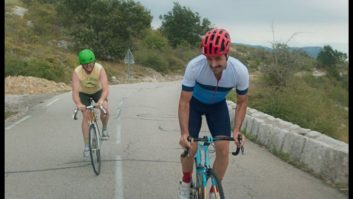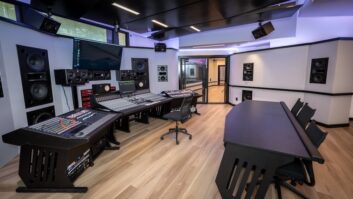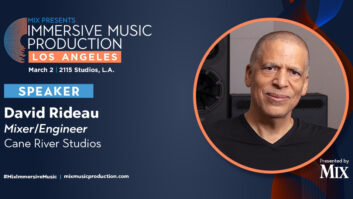
Mix received some beautiful photos of this month’s cover facility as part of FM Design’s submission for “The Class of 2020” studio design feature. We selected one photo for that issue (May), deciding to feature the impressive new complex more prominently in the magazine’s upcoming audio education issue (November). This decision was made in early March. A lot has happened since early March.
The new studios for the Clive Davis Institute of Recorded Music (Brooklyn, N.Y.) were actually completed last year and went online just in time for the fall 2019 semester. The grand opening marked the completion of a five-year process of planning, fundraising, construction and system integration that finally brought all of the program’s scattered facilities together under one roof.
“The department kept growing, despite the fact that we were out of space, so we were renting studios and other spaces all around town,” explains producer/engineer/professor Nick Sansano, who wears many hats at the Clive Davis Institute: Associate Chair, Associate Arts Professor, Director of Production Curriculum; and Co-Director of Musicianship & Performance Curriculum.
“We had two studios on the proper NYU campus on Washington Square, in Greenwich Village, plus we were doing sessions at Oscilloscope Studios [the Beastie Boys’ studio, which became part of the Brooklyn project], Studio G in Brooklyn and Shelter Island in Chelsea,” he continues. “We had rehearsal rooms over near the Theater District and relied on outside venues for performance class space and showcases. We had all these great relationships with producers, engineers, venues, artists and studios, but that’s very difficult to manage. We were running around like crazy.”
A great deal of flexible studio/classroom space is required for the Clive Davis Institute, as the program includes a broad course of study in music performance, production and business, plus the history and criticism of popular music.
“We refer to this important and mandatory area as our Writing, History and Emergent Media curriculum,” says Sansano, whose credits include engineering and production work for Public Enemy, Ice Cube, Sonic Youth, a vast array of international artists and more.
Sansano works primarily with sophomores in the program, while longtime professor—and Grammy/multiple Latin Grammy-winner—Jim Anderson does a lot of work with freshmen, including teaching an essential course in Critical Listening. “When we started talking about the Brooklyn studios, that was an important thing that I fought for,” Anderson says. “We needed that space where we can sit down and listen to material with the best possible playback.”
Everything Open, Then Shut Down
It was back in 2015 when the department received permission to build their complex. In 2016, they began working with architect Mitchell Giurgola, and in 2017 Francis Manzella’s FM Design was selected as the acoustical/studio design firm for the project.
Through close coordination between Clive Davis Institute’s faculty and technical staff, and the architects and designers, a layout was developed that would give the program four control rooms, all of which have associated double-height live rooms. One of the four control rooms also has double-height ceilings and direct windows to the exterior. There is also the multichannel critical listening studio, two smaller production suites with iso booths, five edit suites, two computer labs, as well as rehearsal spaces, faculty offices, multimedia spaces, piano and DJ practice rooms, and breakout/meeting spaces.
The studios were open for about six months before Covid-19 hit and New York shut down.
“We found out on a Monday that on Wednesday we’re closing,” Anderson recalls. “My [Critical Listening] class was on Tuesday. I thought, okay, I have two more things to show them—time delay, and adding reverb and decay—and I guess I’m doing it tomorrow. So I told the students what we were going to do that day, ‘You know, just in case we don’t come back.’ And they said, ‘What? Do you think that might be possible?’”
Like students all over the U.S., Anderson’s class of freshmen were blindsided when their semester was paused, and when they came back to “class,” it was via Zoom. Anderson knew he needed to do something special to keep his students’ full attention.
“Everybody was in such shock,” Anderson says. “I wanted to remind them of why we’re doing this. So, I brought back two of our illustrious alums. One is Cecile Tournesac. She’s a film music editor working in Paris, and she worked on Rocket Man and Mission Impossible. I had her talk about how our program relates to what she does now. She was very articulate about how every day her work relates directly back to this course. Then she played us a sequence from Rocket Man and everyone could watch her Pro Tools file.
“Then we had Mike Witzer, the mixer for Seth Meyers’ show,” he continues. “He spoke with the kids about the importance of ear training and how it relates to what he does. All of this helped to re-engage the kids on why we do this, and we were able to go from there.”
Having students buy in was crucial, but the technical challenge of teaching critical listening on Zoom remained. Anderson developed some exercises where students could A/B original and remastered versions of songs, among other things. They finished off their spring term with a final that required them to dissect a recording to find artifacts.
Then, in June, New York started to reopen, and the necessary health and safety planning needed to reopen the still barely used Brooklyn studios began. For the Fall 2020 semester, Clive Davis Institute has been able to employ a hybrid learning approach—with some students attending in-person classes and others opting to attend via Zoom—largely because of the studios’ design.
Hybrid Remote/On-Site Education
“We designed the studios, and the whole facility for that matter, to be very open, and that has been a saving grace for us to have live classes,” explains Sansano. “We’re one of the only departments at NYU who felt we had the space and the ventilation to hold classes safely. The fact that we kept things very open without central credenzas in most studios, the fact that we are in a LEED-certified building with no recirculating air, and we have HEPA filters in every room, a large open lobby with multiple elevators, wide hallways, et cetera—these design details really helped us.
“But of course we also have students who opted to be remote, so we also have cameras set up and big Zoom carts, as well, and we’re doing blended classes,” he continues. “For example, I teach a class called Producing the Record with producer and fellow Clive Davis professor Bob Power. We set up three cameras in the control room, and in the live room a fourth camera, which is actually a large Zoom Cart with a camera and screen. We have a camera on the console, a camera on the lecture position, and a camera that can move to show the outboard gear or what have you. And we have the room miked up so they can hear the lecture. We use Zoom for the video and lecture portion and a plug-in called Listento to share higher-bandwidth audio off our DAWs when necessary. It’s cumbersome, but it’s doable.”
The fact that these airy, creative studios are making it possible for the program to hold live classes would undoubtably have been a point of pride for Francis Manzella, who passed away in August. Manzella is remembered by his clients and colleagues as a consummate pro who loved a challenge, always kept the user’s specific needs top of mind, and never lost his sense of humor.

“What can I say about Francis?” Anderson says. “It’s like there was never an obstacle. Everything can get done. He would just figure it out.”
“We’d say, ‘Fran, we want to break through the concrete slab ceiling. We want natural light in all the rooms, but they all have to be isolated from city noise. Fran, we’ve got to totally rebuild Oscilloscope in a different space,’” recalls Sansano. “There were a lot of major hurdles, and that was on top of all the logistics that he had to deal with because everything had to be approved by the university and NYC’s stringent building codes. But he was always this smiling face. After all that, it was like he was adopted as a full-blown member of our Tisch School of the Arts community.
“We all took his death so hard. We are fortunate to have his memory embedded within these studios with us every day.”
The Clive Davis Institute Studios
Challenges, Acoustics, and Selected Equipment
In the absence of studio designer Francis Manzella, we talked to two team members who worked closely with him on the studio designs and equipment selections for the recently reopened studios at the Clive Davis Institute in Brooklyn, N.Y.
Matt Marinelli of Coral Sound not only collaborated with Manzella for more than 20 years on new studio installations but also has used a number of Manzella-designed studios for his own productions. For example, on Valerie June’s The Order of Time, Marinelli served as producer and multi-instrumentalist, tracking in Guilford Sound in Vermont.
Greg Morris met Manzella when Morris was still a college student in the Sound Recording Technology program at UMass Lowell. Morris interned with Manzella in 2012, and the two developed a mutual respect and friendship. After graduation, Morris worked as a consultant for other acoustical design firms until finally joining FM Design as a full-time studio designer during the construction administration phase of the Clive Davis Studios.
Re-Creating Oscilloscope

The Clive Davis Institute was given all of the equipment that came out of The Beastie Boys’ studio, with the idea that Oscilloscope would be re-created within one of the new rooms in Brooklyn. Fortunately, Marinelli knew the gear well, as he had worked with Adam Yauch on the original studio.
“The original Oscilloscope was a great studio—basically a DIY studio for Adam Yauch and the Beastie Boys,” Marinelli says. “In Brooklyn, the complement of equipment is the same, the layout of the equipment is the same, and some of the furniture elements are the same. Those things were just picked up and reinstalled in the same configuration as they were on the original Oscilloscope studio on Canal Street.
“The Clive Davis Institute also wanted to make sure there was a continuum between the two spaces feel-wise, and they wanted to set it apart from the other studios in the facility so that students understood the special nature of that room, the history of the equipment and the people who used it. FM Design replicated the color palette and fabrics, or as close as possible, while being careful to use materials that would stand up to student use over time.
“Fran also had to keep in mind things like points of egress and sightlines between students and an instructor, and into the live room. So the back of the room opens up quite a bit more, and there are tall task chairs across the entire back of the room. It’s a more conducive and acoustically accurate version of the original studio.”

Double-Height Studios, Double the Windows
“The four main live rooms were expanded vertically by breaking through the slab floors of rooms above,” says Morris. “Every room is built in a completely decoupled manner, so basically, each room is built on a raised platform, and the platform itself is isolated from the slab below. Everything that makes up that room is built off of that platform. We go to great lengths to avoid touching any overhead structure, any overhead mechanicals, things like that. It’s a very detailed exercise in coordination there to actually make that happen so that the studios are isolated from street noise, as well as each other.
“Because existing slab-to-slab heights were relatively low for this type of floated construction, we had to make the most of what was available. Finding additional space for HVAC and sprinklers without contacting our isolation ‘shells’ was a challenge.”
Similar Rooms, Different Gear
“They didn’t want the studios to be identical,” Marinelli explains. “They wanted to provide a variety of experiences in each room, with different consoles, so the students would have an idea of some of the different scenarios they might walk into in professional situations. We spent almost two years going through the equipment list because it wasn’t as simple as, ‘Let’s come up with one set of equipment and copy-paste it to every room.’

PHOTO: Carine Puyo
“Studios 2, 3 and 4 have almost identical footprints,” Marinelli says “Studio 1 differs because it’s in the corner. Studio 1 is a Dolby Atmos production room with PMC monitors, but it’s a flexible, multi-use room that allows for stereo work, as well. It has a hybrid setup with a 16-channel 5088 Robert Neve Designs console. Studio 2 is Oscilloscope, with its Neve 8078 board and ATC SCM100ASL monitors. Studio 3 has a brand-new API [Legacy] AXS Console and JBL M2 monitors. Studio 4 has an SSL 9000K and a 5.1 PMC monitor system. The other Atmos space is the Critical Listening Room, which has a monitoring system identical to Studio 1 and is configured for a wide variety of formats, including Atmos.”
Remembering Francis Manzella
Morris and Marinelli honor their colleague and friend:
“Even when I was consulting elsewhere, we always stayed in touch and we’d do track events together with our cars,” Morris says. “Professionally, Fran was a completely selfless leader who truly cared about educating others. When he came into a room, people paid attention and latched onto what he had to say, but he was always open to other opinions. If he thought I had a good read on something, there was never any ego involved.
“It was really the best working relationship that I could have asked for. I don’t have quite the extensive resume that Fran did, but he never made me feel like that mattered.”
“Anyone who knew Fran would say the same thing,” Marinelli says. “He never failed to listen to other people’s ideas, even when it came to things that were clearly within his scope. His body of work shows the principles that he relied on—grounded in solid design and acoustics, and clean, ergonomic aesthetics—but he was incredibly open-minded to everyone he worked with, whether they were clients or other members of the design team. I think his clients would say he took on their project and designed it to fulfill the dreams that they were pursuing. That’s why his studios were never cookie-cutter. They’re creative spaces that each client can walk into and feel ownership of that space.”







